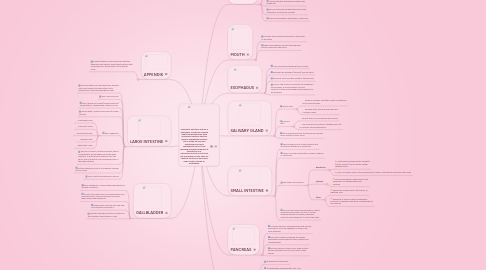
1. STOMACH
1.1. a 'j'-shaped organ, with two openings- the oesophageal and the duodenal- and four regions- the cardia, fundus, body and pylorus.
1.1.1. cardia is the part of the stomach attached to the esophagus.
1.1.2. fundus collects digestive gases,
1.1.3. body secretes pepsinogen and hydrochloric acid,
1.1.4. pylorus is responsible for mucus, gastrin and pepsinogen secretion.
1.2. Temporary food storage
1.3. Control the rate at which food enters the duodenum
1.4. Acid secretion and antibacterial action and Fluidisation of stomach contents
1.5. Preliminary digestion with pepsin, lipases etc.
2. APPENDIX
2.1. scientists have recently proposed that the appendix may harbour and protect bacteria that are beneficial in the function of the human colon
3. LARGE INTESTINE
3.1. removes water from the remainder, passing semi-solid faeces into the rectum to be expelled from the body through the anus
3.2. also called ad colon
3.3. site in which flora-aided (largely bacterial) fermentation of unabsorbed material occurs
3.4. absorb water, sodium and some fat soluble vitamins
3.5. has 5 segments
3.5.1. Ascending colon
3.5.2. Transverse colon
3.5.3. Descending colon
3.5.4. Sigmoid colon
3.5.5. Redundant colnn
3.6. Cecum is a pouch, usually peritoneal, that is considered to be the beginning of the large intestine. It receives fecal material from the ileum, and connects to the ascending colon of the large intestine
3.7. rectum intestinum acts as a temporary storage site for feces.
3.8. Anus control the expulsion of feces
4. ESOPHAGUS
4.1. Also called the swallowing tube or gullet
4.2. between the windpipe (trachea) and the spine
4.3. transport food from the mouth to the stomach.
4.4. Food in the mouth is carried to the esophagus by peristalsis, a process where muscles contract to push food through the esophagus to the stomach
5. MOUTH
5.1. it breaks down food mechanically by the action of the teeth
5.2. begins the digestion of starch through the enzyme amylase in the saliva.
6. SALIVARY GLAND
6.1. serous cells
6.1.1. produce a watery fluid that contains a digestive juice called amylase.
6.1.2. amylase splits starch and glycerol into complex sugars
6.2. mucous cells.
6.2.1. secrete a thick, sticky liquid called mucus
6.2.2. mucus binds food particles together and acts to lubricate during swallowing.
6.3. the fluids produced by the serous and mucous cells combine to form saliva
7. SMALL INTESTINE
7.1. the site where most of the chemical and mechanical digestion is carried out
7.2. Where all of the absorption of useful materials is carried out
7.3. has three main sections
7.3.1. duodenum
7.3.1.1. neutralize the acidic gastric contents (called 'chyme') and to initiate further digestionnode
7.3.1.2. Fats are broken down in the duodenum by "lipase" from the pancreas into fatty acids.
7.3.2. jejunum
7.3.2.1. has a lining which is specialized in the absorption of carbohydrates and proteins.
7.3.3. ileum
7.3.3.1. absorb the nutrients from the chyme, or digested food.
7.3.3.2. absorbs B12 and bile salts and whatever products of digestion that were not absorbed by the jejunum
